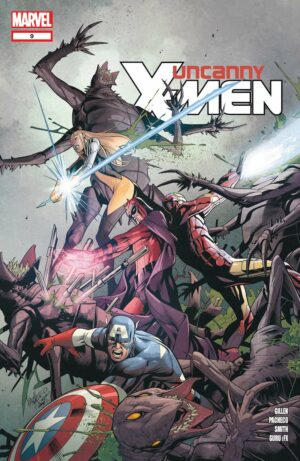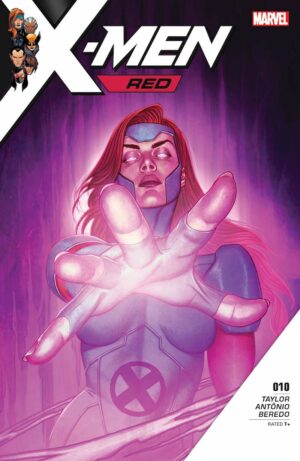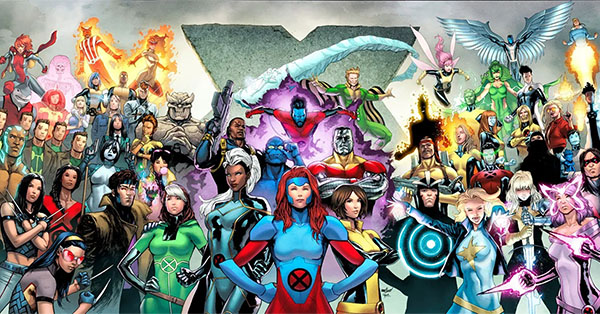This week my X-Men guide update includes an unusual event: the birth of a new guide page! Now that we have hindsight on the storylines and collections of X-Men from 2010 to 2019, I’ve consolidated all of the main X-Men flagship titles into a single guide. Welcome to the all-new, all-different Guide to X-Men flagship titles (2010-2019)!
Guide to X-Men flagship titles (2010-2019)
This page consolidates the contents of a pair of older pages – a “Guide to Uncanny X-Men, Vol. 2-5” and “Guide to X-Men, Vol. 3 & 4,” though some of the former contents of those pages now lives in the recently revised Guide to New Mutants & Young X-Men.
At the time I original created my X-Guides, the “Second Coming” storyline was still ongoing and the map of X-Men titles seemed so obvious. There had always been and would always be the 1963 volume of Uncanny X-Men, often accompanied by an adjectiveless X-Men title as well as many supporting teams and titles like New Mutants, X-Force, X-Factor, and Astonishing X-Men.
I thought I had it all figured out. But, when it comes to the X-Men, that feeling never lasts for long.

At the time, no one realized that Jason Aaron and Kieron Gillen would be steering the line into a schism that would end the venerable first volume of Uncanny X-Men. When Schism and Gillen’s new title were announced in 2011, I launched the first first additional X-Men guide page created after the original launch of Crushing Comics in 2010. The page was titled “Guide to Uncanny X-Men, Vol. 2,” and I expected the title to last for hundreds of further issues.
(Meanwhile, I also hurriedly prepared a Wolverine page to contain Jason Aaron’s new Wolverine & The X-Men.)
Instead, that second volume of Uncanny X-Men turned out to be entirely a prelude to Avengers vs, X-Men, which in turn lead to Marvel’s linewide relaunch in Marvel Now. That begat a third volume of Uncanny X-Men, a fourth volume of adjectiveless X-Men, the All-New X-Men title following the teen original team in the modern day, and a new Uncanny Avengers title that was positioned as the flagship of Marvel’s entire publishing line.
Thus began a decade of confusion about what the “main” X-Men title really was at any given time.
That continued into All-New All-Different Marvel with the launch of another trio of flagship books, and then into ResurrXion with another pair of flagships with color-coded titles, before finally centering briefly on a fifth volume of Uncanny X-Men in 2018 prior to Jonathan Hickman’s takeover of the line 2019 with a fifth volume of adjectiveless X-Men.
I struggled to bounce back and forth between adding all of those new volumes to “Guide to Uncanny X-Men, Vol. 2-5 AKA X-Men Flagships” and “Guide to X-Men, Vol. 3 & 4,” but after so many relaunches the internal logic of that pair of guides didn’t even make sense to me.
Why wasn’t Wolverine & The X-Men a “flagship” by my reckoning? Why did I have X-Men Gold on the Uncanny page rather than the adjectiveless page? What was the point of interspersing the teen team’s books with other titles in current continuity when they told a single continuous story?
With hindsight, the way to organize these books in the long term seems so much simpler than it did in the thick of reading them all.
Both Uncanny X-Men and adjectiveless X-Men can co-exist on the same page in this period, since both had several distinct runs and there was no real difference in importance or primacy between the two titles.
 Extraordinary X-Men, X-Men Gold, & X-Men Red were all “flagship” books in their periods, because they each followed the ostensible “leader” of the mutant race at the time (Storm, Kitty, & Jean, respectively).
Extraordinary X-Men, X-Men Gold, & X-Men Red were all “flagship” books in their periods, because they each followed the ostensible “leader” of the mutant race at the time (Storm, Kitty, & Jean, respectively).
Books that focused on scholastic environments and teen characters could be important to the line, but ultimately they all fit better into the Guide to New Mutants & Young X-Men because they share the trait of being focused on a setting and a particular cast. That includes all of the story of the teen X-Men through All-New X-Men (and, later, X-Men Blue), even if they sometimes become the center stage for X-Men continuity. So did the original New Mutants, back in the day.
Finally, the Age of Krakoa requires a guide entirely of its own (which is currently exclusive to Patrons of CK as I continue to add more detail to it). The pair of adjectiveless X-Men flagships in the Age of Krakoa are inextricable from other key titles like Marauders, SWORD, Immortal X-Men, and X-Men Red.
(And, it wouldn’t do anyone any good to group that new X-Men Red title focused on Storm & Magneto alongside the previous X-Men Red volume focused on Jean.)
I couldn’t have articulated any of that so clearly 13 years ago this month as I began to outline the original Crushing Comics launch guides. I couldn’t have even articulated it a year ago as I began the painstaking process of updating all of my X-Men guides to the present day! It only entirely made sense to me in the past few days as I worked to update this Guide to X-Men flagship titles (2010-2019).
And, this might not be the answer forever. Things could change and become clearer still if the Age of Krakoa concludes after its new announced “Fall of X” starting later this year.
All of that is why I started my Crushing Comics Guide to Marvel Comics in 2010 and why it continues to exist today in 2023. It’s absurd to expect any one comics fan to make sense of all of this just to follow or catch up on X-Men comics. Marvel has an amazing all-you-can-eat digital service with Marvel Unlimited, but they don’t do enough to make sense of this tangle of volumes and continuity. They especially don’t do anything to easily explain how it has all been collected for people who prefer to read in physical format.
When it comes to making sense of the X-Men, Crushing Krisis will always be the best place on the internet to make sense of their publishing history, collected editions, and reading order.
This isn’t the end of my series of major X-Men guide updates! You’re not going to want to miss the guide I have in store for you next Friday.
